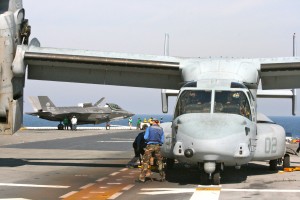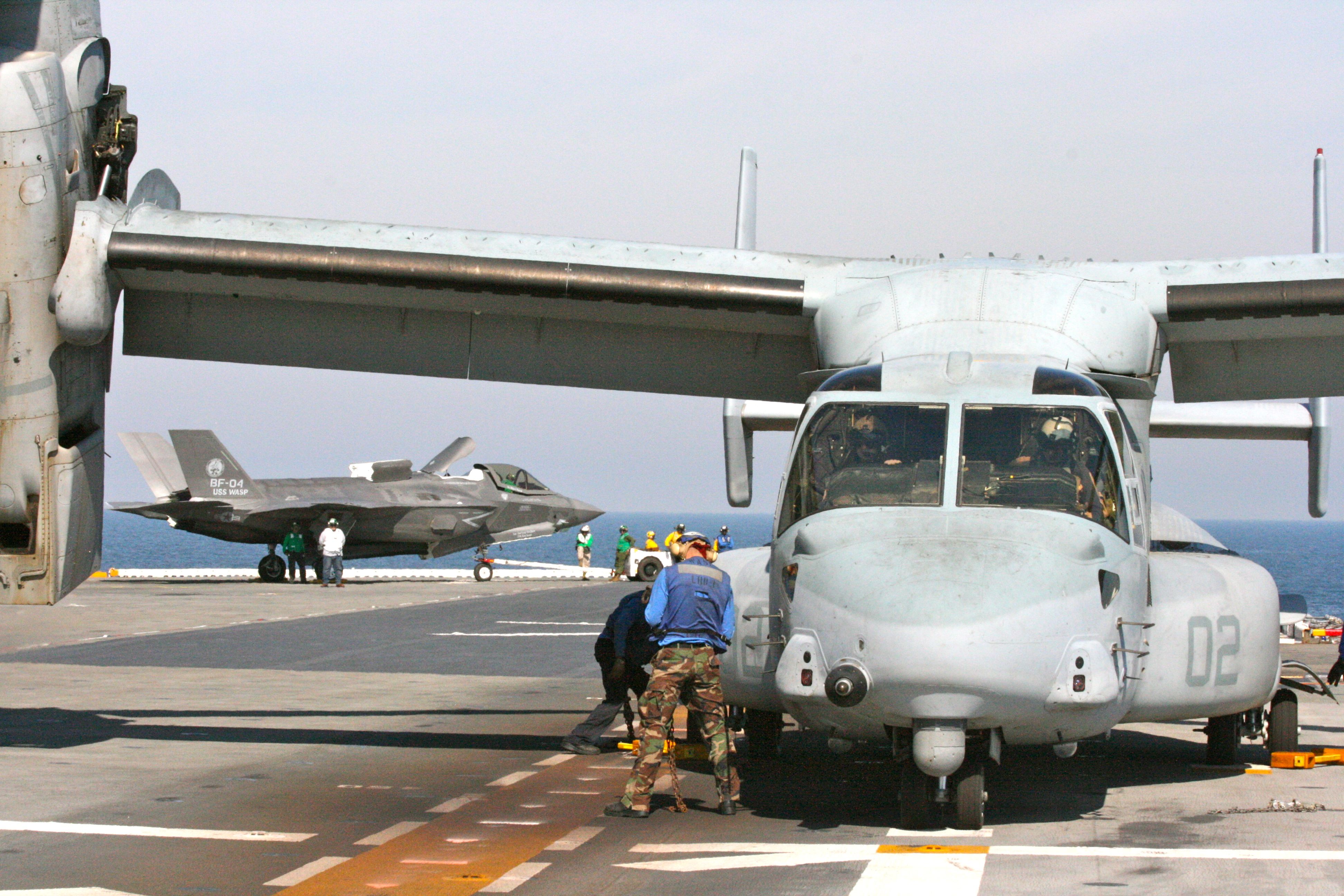12/09/2011 by Ed Timperlake and Robbin Laird
Enhanced Efficiencies in Use of Ship Deck Space: The USN-USMC Team Shows the Way
As assets are diminished for U.S. defense forces, it is important to enhance the combat value of the assets which remain. Important modernization and upgrades are the essential points. The USN-USMC team is demonstrating a key way ahead to get much greater value from the key Gator navy ship, the LHD.
But first a brutal fact of life that has not been experienced by US Naval Forces since WWII. From the beginning of human conflict, there has always been a pre-combat action reaction cycle of developing military technology. All conventional war fighting technology is relative against a reactive potential enemy. When a shooting war breaks out the enemy gets a sizeable vote and history shows in combat ships are disabled and sunk.
21st Century Aircraft Carrier issues From This Perspective
Ships sink—even Capital Ships and they must be combat capable well designed, and tactically and strategically relevant.
The British Battle Cruiser “The Mighty Hood” was sunk in a matter of minutes in engaging the German Battleship Bismarck. The German’s opening salvo found a design deficiency on the Hood and 1400 sailors died –the size of an Infantry Battalion. There were four survivors.
The British pressed on the attack to sink the Bismarck and with outair cover a 200 kt biplane Swordfish torpedo bomber hit the Bismarck’s rudder doming the ship to going under by a series of attacks by the British surface fleet.
Soon after, it was the Royal Navy’s time to learn a lesson about not having air cover when Japanese land based planes sank the Battle Ship HMS Prince of Wales and the Battle Cruiser Repulse in the Naval Battle off Malaya. The British did not have air cover and paid a terrible price.
The Pacific Carrier Air war battle at sea between Imperial Japanese forces and the USN was resolved in essentially four minutes at the Battle of Midway. The Japanese Admiral should by pure numbers won the Battle. But a complex battle plan and brilliant code breaking with legendary courage by USN Carrier pilots and the tide of Battle was turned in one engagement.
The responsibility carried by a Navy Carrier Battle Group (CBG) commander is huge because one miscalculation against a determined foe and the CBG can take significant damage.
But history also shows modern Navy ships can defend themselves. The tragedy of the USS Forestall off Vietnam shows the world that a modern Carrier can take significant hits and keep afloat.
Combat and accidents (Forrest Fire) tell us with proper design features and well-trained battle damage control training it is hard to sink a Carrier.
Tactically, the current equation for US Navy Carrier Battle Groups is to trading distance for effectiveness- especially to maneuver in Blue Water with appropriate C4ISR connections to CAP, Aegis, subs, satellites AF, allies and “tron” warfare capabilities.
Ultimately, in the action reaction cycle of offensive and defense combat the CBG will eventually close with and destroy the enemy but distance especially in AirSea battle planning is also always relative. In the Pacific with a “wasting asset” argument being made enemy subs and surface IRBMs, with other land and air launched cruise missiles and Satellite remote targeting are all of great concern and factor into Blue Water maneuvering.
Away from the CBG maneuvering, the USN/USMC team afloat has the exact same issues but even more because of the close in proximity for their combat engagements in the power projection over the beach mission. Close to the shore, the threat is to perhaps take direct fire if they get within range. Shore based arttillery and closer in and more accurate PGMs can add to the gauntlet of combat challenges and planning scenarios.
Therefore whatever emerging new weapons and aircraft in the ARG that enable enhance distance, maneuverability and surprise must be supported so the Amphib Fleet has a higher probability of not taking a significant hit.
Give the USMC/USN combat warriors the technology and the con-ops will follow.

So what to do?
First, the US Air Force is huge asset especially in the Pacific –unfortunately because of political decisions the USAF is limited in numbers of F-22s and B-2s—in addition to fewer refueling tankers. The decision to stop the F-22 was very short sighted because in addition to being the best fighter in the world in a straight up AA fight it is also the best SEAD (suppression of enemy air defense) platform ever to fly.
The fact the AF will have the F-33A in sufficient numbers is also critical.
On the ocean in the not to distant future, the next huge and revolutionary asset especially for the distances around the Pacific Rim is a new 21st Century USN/USMC combat team afloat. With American political will supporting those who will go in harms way, Amphibious Ready Groups, with the F-35B and V-22 will fully be fully enable combat capable carriers against all threats. Our allies will soon follow.
In creating what we have called the newly enabled ARG or Agile Response Group will be a viable additional deterrent to avoid a Pacific war but if called on to engage the USN/USMC ARG can fight and win.
https://sldinfo.com/littoral-combat-ship-and-the-newly-enabled-arg/
By adding, new combat capabilities, notably the V-22 and the F-35B, the ARG becomes a much more potent combat resource, and a welcome addition to CBG con-ops. In an age of diminishing physical assets – in this case ships – getting more punch for the buck is a key consideration. The tactical contribution is the ARG becomes part of a scalable response with respect to any evolving flash point crisis.
Like everything in life the cliché “the Devil is in the details” must be addressed. There good news because of another significant aspect of the USN-USMC modernization approach. The ability to make better use of Amphib deck and below deck space is significantly enhanced by the new systems.
First, having the two modernized helos – the Zulu and Yankee Class – use the SAME engines means that support for two different engines aboard the ship is no longer necessary. This frees up both manpower and maintenance space aboard the ship.
Second, the V-22 compared to the CH-46 uses 20% less space to fold its wings, providing more space aboard the deck for combat air or helo operations. The lateral orientation of the blades permits this deck saving option. For example, this means that one can spot 5 V-22s aboard the deck in a space, which formerly would hold 3 helos.
Third, the F-35B operates – dependent on loads and other conditions – in a smaller space than the Harrier. Because of internal loading of weapons, the ability to turn around the aircraft will be much more rapid in many conditions than the Harriers as well.
The key point is the F-35B is a ground attack replacement for the AV-8, and F/A-18 and air-to-air fighter replacement for the Hornet in that role and also an EW/ECM replacement for the EA-6B. The F-35B also has the untapped combat potential to also sortie continuous battle knowledge because of the revolutionary “Z-axias” C4ISR-D, “D” is for combat decisions being made in the cockpit.
https://sldinfo.com/preparing-for-the-f-35b-transition-mawts-re-shapes-its-curriculum/
Physically, the take off-range for the F-35B aboard an LHD Wasp Class ship will be similar to the Harrier operating in the 600-700 foot range. But because of the inherent capabilities of the F-35B, it can be used without a full up weapons ordinance and take off in a shorter range than a Harrier and be combat relevant. The question revolves around the weapons load the aircraft will be using in different mission sets.
And the LHDs with F-35Bs aboard can have a significant carrier role. 15 F-35Bs can operate off of the deck with 4 more below deck in the Hangers. The normal configuration would be to deck spot 6 F-35Bs to allow for the other elements to support the MEU.
So with the F-35B, the V-22, improved helos the ARG will pack a very significant combat punch across a wide front of action from the sea and to the sea, dispersed and ready.
As Commandant of the USMC, General Amos pointed out in his Congress testimony as reported in Defense News on Nov2, 2011 “In an era of shrinking budgets, the addition of the F-35B to the naval aviation arsenal will effectively double the number of available aircraft carriers, Amos said. The large-deck amphibious assault ships essentially become small carriers with the F-35B embarked.”


